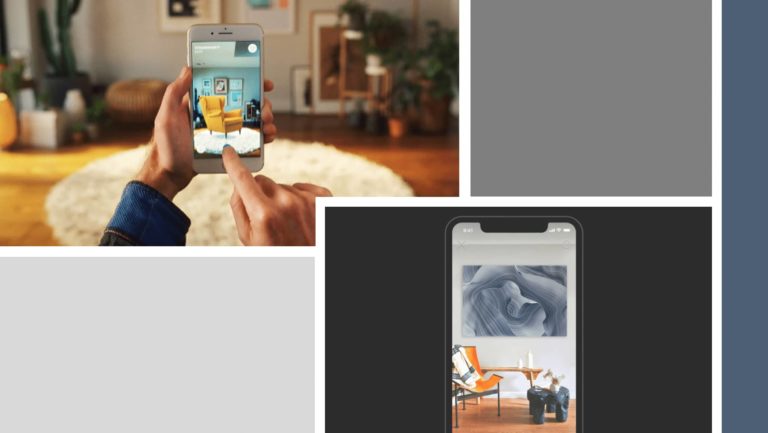
AR marketing involves immersive product try-ons or visualizing products in your physical space. The levels of interactivity that it offers have been shown to outperform traditional digital advertising on several key metrics. Why is this, and how can brands benefit best?
Here are just a few ways AR marketing is proving itself today…
AR drives brand awareness, ad recall, and many other metrics
Meta’s Foresight group recently conducted a study that found that augmented reality “can significantly increase campaign performance”, compared to “business-as-usual (BAU) campaigns” that do not incorporate AR. The study found “with 90% confidence that campaigns combining BAU ads and AR ads outperformed BAU campaigns alone in driving awareness”. In other words: Advertisements that utilized AR created a greater lift in brand awareness than traditional Facebook ads did.
AR-supported campaigns were almost three times more effective than non-AR campaigns
What really stands out in this study are the large effect sizes: On average, AR increased the lift of brand awareness by 2 percentage points, from a median of 1.1% awareness lift for traditional Facebook ads to a median of 3.1% awareness lift for AR-supported campaigns.
These numbers may seem small but they nevertheless indicate that AR-supported campaigns were almost three times more effective than non-AR campaigns at the top of the purchase funnel.
And this higher performance even comes at a discount. Meta claimed that campaigns that incorporated AR also had a 59% lower cost for driving awareness.
Awareness was not the only metric in which AR outperformed traditional Facebook ad formats. Meta gives a few more details for four different brands:
- Mini: 890K reach, 28 seconds average engagement time, 2.9X lift in ad recall, 11.25X lift in brand favorability, 6X lift in brand recommendation
- Avon: 200K reach, 40K leads, 1.7X lift in action intent, 2.2X lift in brand recommendation
- Netmarble (A3: Still Alive mobile game): 1.5X lift in ad recall, 4.1X lift in brand awareness, 1.4X lift in brand familiarity
- Rak’n’Roll (oncological foundation in Poland): 6.6X lift in brand awareness, 1.4X lift in brand familiarity, 39.6X lift in donors
Overall, these figures demonstrate AR’s ability to drive crucial metrics such as ad recall, brand awareness, brand favorability, brand familiarity, action intent, and actual behavior.
But let’s dig a litter deeper: Why might AR be so effective? And how can brands best benefit from AR?
AR ads increase dwell time
Augmented reality ads are effective because they increase consumer engagement. I know that sounds obvious, but give me a moment to make a deeper point here.
In academic literature, we use a specific definition of ‘consumer engagement’ that points to several dimensions of why AR ads are effective. Properly defined, consumer engagement refers to consumers’ cognitive, emotional, and/or behavioral activities during specific interactive, co-creative experiences with a brand and/or other members of a brand community.
AR increases the time consumers spend interacting with a brand, providing more opportunity to encode and store brand-related information
One clear benefit of AR is that consumers simply spend more time interacting with a brand (i.e., the behavioral component of the consumer engagement concept).
For example in the Mini campaign noted above, consumers engaged 28 seconds on average. In comparison, average view time of video ads on Facebook is around 18 seconds (2018 data). I could not find any data on how quickly consumers scroll past static sponsored posts on social media. However, I doubt it is much more than the 0.7 seconds consumers gaze, on average, at banner ads in desktop computing environments (2016 data).
Granted, I compare Mini’s single data point with average numbers here, but I think my point makes intuitive sense. Engaging with AR typically draws consumers in to interact with AR content (e.g, change the color of a Mini or play the AR mini-game), whereas videos and images are passively consumed. All that extra time spent within the ad increases the length of time consumers think about the brand, which naturally increases ad recall, brand awareness, and other metrics.
AR increases memory encoding
The other two dimensions of the ‘consumer engagement’ construct are levels of brand-related thought processing (i.e., cognitive dimension) and positive brand-related effect (i.e., emotional dimension) during consumer-brand interactions.
Both dimensions impact how well consumers remember brand-related information. More elaborate cognitive processing better integrates new information within the associative network in our brains. The more cognitive pathways lead to a certain piece of information, the easier it is to retrieve it. Furthermore, higher emotional intensity of a stimulus is directly related to how well it is encoded into long-term memory. This makes a lot of sense from an evolutionary perspective: Our ancestors who got a really bad stomach ache after sampling some newly found berries (i.e., high emotional intensity while processing information) benefited from remembering and avoiding this particular berry after a single incident.
AR outperforms purely digital media formats in terms of creating brand knowledge in consumers’ minds
Another study conducted by Zappar showed that AR outperforms purely digital media formats in terms of paying attention, memory encoding, and ultimately memory. Zappar conducted a neuroscience experiment in which consumers either interacted with an AR app or a purely digital media experience on a similar topic. For example, one group of consumers examined furniture via IKEA Place in AR, whereas another group browsed IKEA’s webpage (without AR). Throughout the experiment, Zappar used steady state topography (SST) brain-imaging technology to measure brain activity in regions associated with attention, information processing intensity (labeled ‘engagement’ in Zappar’s chart), emotional intensity, and memory.
Assuming that Zappar controlled for length of interaction between both groups (which is likely, given that their experimental design otherwise seems robust), this study provides very convincing evidence that AR-empowered experiences surpass purely digital experiences for building brand knowledge in consumers’ minds.
In the AR scenario (pink area), test subjects showed 1.9 times higher levels of visual attention than in the non-AR scenario (orange area). Left-brain visual attention focuses on details (and thus benefits information processing), whereas right-brain visual attention focuses on the overall feel of something (and thus benefits emotional intensity).
The intensity of processing information (labeled ‘engagement’ in the figure) was about 2.9 times higher for AR than for non-AR, and emotional intensity was also stronger for AR by about 33%.
Given these strong benefits on attention, information processing, and emotional intensity, it is little surprise that this study also found that AR outshines non-AR experiences for encoding information into long-term memory. Zappar claims that memory encoding was 70% higher in the AR task scenario compared to the non-AR task scenario.
What does this all mean? AR makes consumers pay more attention, and process information more deeply and with more emotional intensity, which leads to higher levels of memory encoding. In lay terms, AR is a superior tool for creating brand-related information in consumers’ minds.
How can brands benefit?
By using a more complex and rigorous definition of consumer engagement that highlights the behavioral, cognitive, and emotional dimensions of engagement, marketers and AR experience designers can create more effective AR advertisements.
One important first step is to ask what drives these phenomenal results for AR? Yes, to some extent this is an effect of longer dwell time, but stopping at this simplistic view would be a grave mistake because it reduces the engagement concept to a single dimension.
From a tactical standpoint, this all means that you should ask yourself what consumers should do with all that extra dwell time, and design the AR experience accordingly.
Zappar’s study shows AR’s potential to encode brand and product-related information into consumers’ memory through cognitive and emotional pathways. Marketers can exploit this by designing AR content accordingly.
Mini is an AR veteran which has utilized AR since 2008, but in my humble opinion, their latest advertisement misses the mark. Mini realized that more people research cars online than ever before, and I am sure that they also noticed how mobile online traffic has already surpassed desktop traffic. Rahul Mahtani, communications manager at Mini, explained that the goal of the AR ad was to ride this trend:
“So, while there are many different ways brands can tap into AR, we wanted to focus on utility for those in the learning phase.”
I think this is a great goal. It leverages a strength of AR, namely that AR outperforms other media formats in terms of information processing by 290% and memory encoding by 70% (see Zappar’s study above). However, Mini’s AR campaign misses out on a lot of opportunities to achieve this goal.
The problem lies in the execution. It seems that AR here is simply used to visualize the car in consumers’ spaces, in different colors (shown here).
If the brand really wanted to provide utility during the learning phase (again, this is a solid goal for AR), then why not provide richer details on the car through text overlays? “Oh no”, I hear you say, “that’s so early 2000s AR!” But does that necessarily mean it is bad? Could consumers not see an amazing and lifelike rendering of the car, and also tab on different areas or contact points on the car to receive further information? AR users are already highly engaged in cognitive ways, so why not offer them details to store in their memory?
OnePlus Nord provides a great counter-example that shows how AR can support learning goals with force. The image below, which is from its live launch via Blippar’s AR platform (video here), shows the potential AR has for letting consumers explore a product and learn about detailed product attributes.
For brands, this means that they have to think beyond just creating lifelike and high-fidelity AR assets of their products. They also have to invest more time and focus on planning the AR experience. AR platforms like Meta and Snapchat should therefore keep expanding their tools and formats so that they can accommodate a wider variety of AR executions.
The key takeaway here is that displaying lifelike AR assets is rarely enough for advertising purposes. Brands need to invest time and resources into the strategy and creative of AR ads.
This is just one example of how a more strategic and research-driven approach can help marketers increase the effectiveness of AR advertising. Many more insights could be discussed. For example, the consumer engagement concept also highlights that consumers not only interact with the brand itself but also with “other members of a brand community”. The Mini advertisement allows consumers to capture a video or image, but is this practice well guided? Are consumers prompted (within the AR experience or through non-AR communications) to go outside and show their new Mini in their driveway?
And then there are, of course, a host of other beneficial outcomes of consumer engagement, beyond awareness and brand knowledge/familiarity: Engagement also leads to consumer-brand relationships, higher value perceptions of brands, loyalty, and advocacy. AR experiences can be designed with these goals in mind, and brands should track these outcomes.
Displaying lifelike AR assets is not enough. Brands need to strategize how different AR execution can best achieve their goals.
In conclusion, there are many good reasons why marketers should embrace AR advertising. The payoffs can be enormous, especially when marketers and designers understand what AR’s particular strengths are… and lean into those strengths as they map to campaign goals.
 Dr. Joachim Scholz is a marketing professor with an academic focus on AR. See his original writings on Medium.
Dr. Joachim Scholz is a marketing professor with an academic focus on AR. See his original writings on Medium.






